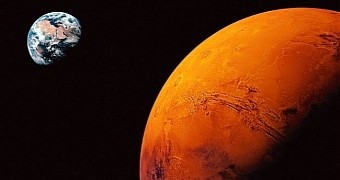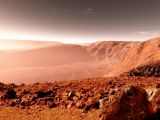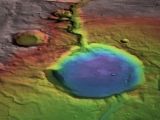Evidence obtained over the years indicates that, eons ago, Mars was home to rivers, streams and even lakes. The thing is that, seeing how cold the Red Planet has been all throughout its history, scientists are having trouble figuring out how river, stream and lake beds came to form on the Red Planet.
In a paper in the journal Nature Geoscience, specialists with the US' Brown University argue that volcanic activity can explain the creation of these geological structures. Thus, they believe that it was massive eruptions that birthed liquid water on Mars and even made it flow.
How volcanoes forever altered Mars' appearance
Together with researchers with Israel's Weizmann Institute of Science, the Brown University specialists explain that, as shown by recent climate models, young Mars was a freakishly cold place. This was because, billions of years ago, the Sun was dimmer than it now is.
What's more, they argue that, when the Red Planet was still an adolescent, its atmosphere was too thin to be able to heat its surface and thus make it possible for liquid water to form and flow across it.
To explain the presence of ancient river, stream and lake beds on Mars, the scientists say that, all things considered, it could be that it was volcanic activity that fostered the rise in temperature needed to allow for the creation of liquid water.
This hypothesis is backed up by data indicating that water flowed on the surface of the Red Planet some 3.7 billion years ago, which is around the time massive volcanoes were busy couching out lava and all sorts of gases.
Not your usual volcanic eruptions
Here on Earth, volcanic eruptions trigger a drop in temperatures by spewing out ash and all sorts of compounds that reflect the rays reaching our planet. On Mars, however, ancient volcanoes appear to have caused temperatures to rise.
The Brown University researchers and their colleagues with Israel's Weizmann Institute of Science argue that this happened because the sulfur dioxide released during such events acted as a greenhouse gas and caused the planet's equatorial region to warm.
On the other hand, sulfuric acid particles released by Martian volcanoes bounded with dust particles floating about in the planet's atmosphere, reducing its ability to reflect rays. This too translated into an increase in surface temperatures.
It's important to note that such periods of warming were few and far between. Still, it appears that they were more than enough to birth rivers, streams and lakes on the Red Planet, and keep them alive for a few hundred years at a time.
“This new analysis provides a mechanism for episodic periods of heating and melting of snow and ice that could have each lasted decades to centuries. We find that volcanism can bring the temperature on early Mars above the melting point for decades to centuries, causing episodic periods of stream and lake formation,” explains study co-author James W. Head.
The researcher further says that, if primitive life forms ever existed on Mars, chances are that it is in such river, stream and lake beds that scientists will one day find evidence of their presence on the Red Planet.

 14 DAY TRIAL //
14 DAY TRIAL // 



